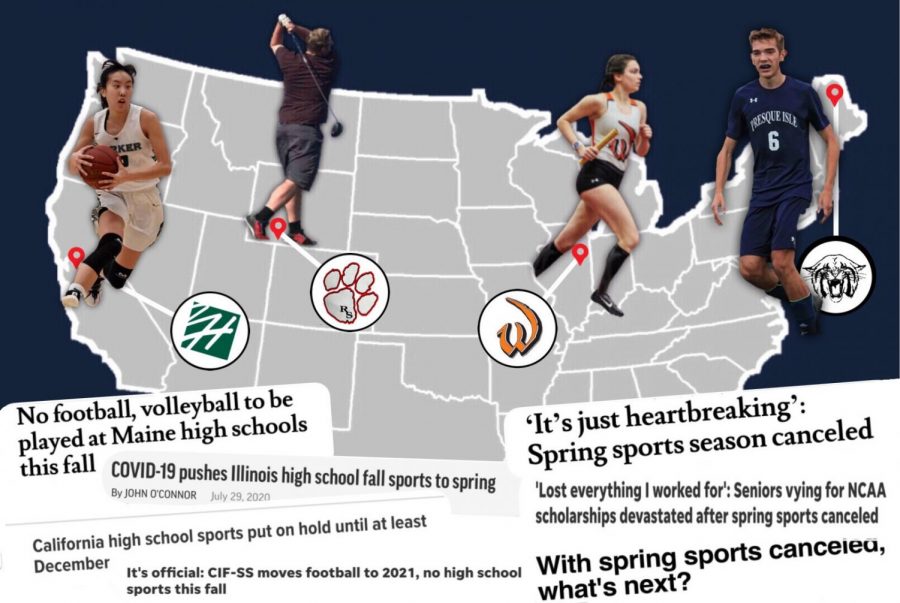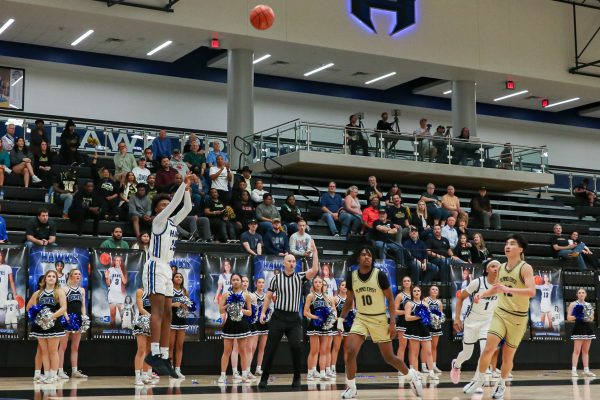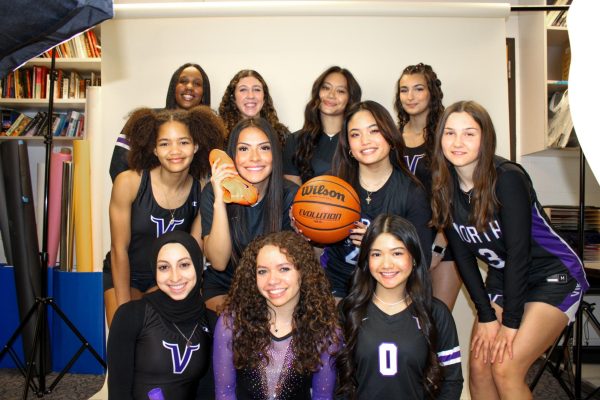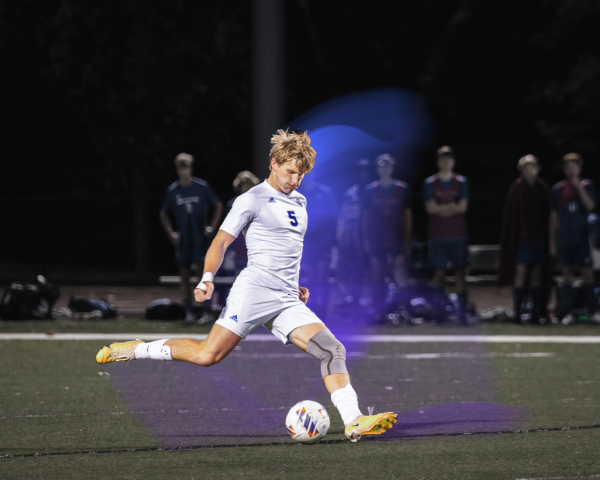An Unexpected Year Unites Athletes from Coast to Coast
Athletes from around the nation have found common ground amidst unprecedented circumstances surrounding their seasons.
“It crushed me to know that we wouldn’t have anything in the spring, so I kind of lost hope,” said Presque Isle senior Conner Michaud.
October 1, 2020
September 21st, 2001. Mike Piazza launches a blast into deep center to send Shea Stadium into pandemonium just 10 days after the tragedy at the World Trade Center. April 17th, 2013, barely 48 hours removed from the bombing at the Boston marathon, the TD Garden crowd erupts in a goosebump inducing rendition of the national anthem as a rallying cry for their city. Throughout history, sports have been a lifeline that Americans can hold on to, even in the darkest of hours. So in mid-March, when a crisis unlike any we have faced in modern history appeared to be looming over us, one so daunting that it caused sports as we know it to crumble, the end seemed near.
This was not some regionally centered issue where people could use the rallying power of togetherness through competition to move past the obstacle stronger than before. It was a national crisis, global even, one in which togetherness, at least in the physical sense, was not the solution, but in fact a vessel to further the problem. This caused a rather predictable state of confusion for a society reliant on sporting events as a major part of their lifestyle. In interviews with high school athletes from around the country as the fall season approaches, students echo the challenge of balancing competitive focus with uncertainty.
Mardi Lorenz ‘21, Lincoln Way West High School
New Lenox, Illinois
“I wanted to go to states,” said Mardi Lorenz of Lincoln Way West High School in northern Illinois over the phone earlier this month. “I was the most in shape I’ve ever been, and being a high school junior, [a prime year for recruitment] I didn’t have opportunities to get my best times for scholarships and stuff like that.”
Lorenz, a three sport athlete (cross country, indoor and outdoor track and field) and a rising senior, watched friends and teammates graduate without a final send off to their high school sports career, and hopes her upcoming seasons, as well as the other events that culminate a high school career, don’t share the same fate. “I have so many things (going on), it’s senior year, I’m in the welcome committee and all this stuff, like (going to) football games and all that, and it’s all kinda gone.”
The looming threat of what could be to come has not stopped the training regiment headed into the fall however, though changes, like in all other facets of life, had to be made. “Usually we take a bus to different trails, but now you have to wear a mask on it, and they can only have a certain number of people, and then when we’re at the trails we have to wear a mask when we’re not exercising and stuff like that.”
While understanding of the measures and their purpose, Lorenz also questions their effectiveness in a team scenario. “I’ve been training with my team for the whole summer, so we’ve already been around each other all the time. I understand that maybe the whole school shouldn’t be all over each other all the time, but with my team, I shouldn’t really have to stay six feet apart from them if I was just hanging out with them the other day.”
If the seasons do end up happening, there will be quite a shift for student athletes in Illinois. “They’re having tennis, cross country and golf in the fall, and then they’re moving a bunch of the fall sports to spring, and a bunch of the spring sports to summer.” This, as one may imagine, births the strange scenario that pits graduated seniors, most of whom with their first semester of college just ahead of them, competing for the school they no longer attend. “I don’t know how much motivation I’m going to have,” Lorenz said when discussing the possibility of summer sports. “Usually, the track season is five months long [with both indoor and outdoor], and now it’s going to be like a month and a half. It’s going to be so hot that it’s probably just going to be more for fun than actual competition.”
Kaden Allen ‘21, Rock Springs High School
Rock Springs, Wyoming
Further west, in Wyoming, Kaden Allen, a senior at Rock Springs High School feels for those who lost out on their last opportunity to compete at the high school level, but he himself has accepted whatever is in store for his athletic future. “A lot of people missed out on doing their sport their senior year which is a bit of a bummer, but I didn’t really have too many problems with it,” said Allen. “It just is what it is.”
As a golfer, he personally has not seen a great deal of restrictions, but he has seen strict policies imposed on other athletes close to him. “Golf isn’t really too affected, the weirdest things they’ve implemented are some rules around the cup, where you just have to be extra conscious about how close to other people you are and that kind of thing. My girlfriend is a swimmer though, and they have to put their mask on as soon as they come out of the pool, but that’s about it.”
Like most states, Wyoming is going ahead with fall sports, but Allen can see some potential problems in the future given the nature of the state’s identity. “I live in a kind of right leaning state, and masks and that kind of thing are not too agreeable for a lot of folks in town at least, so I think that could be some trouble down the line.”
As the year marches on, he is concerned, even as an athlete himself, for what a fulfilled sports season could bring, but supports those who wish it to go forward at the same time. “I don’t know if it’s the best idea,” Allen said. “I honestly think we should just be safe and wait and let it all blow over, but I definitely understand why a lot of people are doing it, and if they feel safe doing it, then go ahead. I think they need to be outspoken for what they believe in.”
Alexa Lowe ‘22, The Harker School
San Jose, California
Nearly 1000 miles away, Alexa Lowe of The Harker School in San Jose feels the same way. “I think people definitely do want to play,” Lowe said. “Athletes are really bummed out by this, but at the same time, I wouldn’t support that movement [going full steam ahead in the fall] because I think if you really want to be able to have a full season earlier, I would want to wait until things are better and then play your sports properly.”
Lowe, a junior and two sport varsity athlete, says her decision on that matter is weighted against the possible consequences. “If young people like us get the Coronavirus, our lungs might get damaged forever. I just don’t think it’s wise to play when you know that there’s the threat of a pandemic going around and that you could harm the people around you.”
Despite everything going on in the early months of the pandemic, Lowe still found ways to practice and improve as an athlete. “I was really sad that I didn’t get to go to a single meet for my sophomore season,” said Lowe. “So after quarantine started, every morning before online school I would go to a local high school where they still had the track open and I would practice jumping because my main events are jumping.”
That was not the case for many other athletes she knew, however. “For basketball, most people just shot around at baskets they had at home or they just didn’t work out. Most people just didn’t work out.”
California, unlike the previous two states mentioned, will not have a typical fall sports season, instead choosing to attempt to fit three seasons in the span of two. “If things do continue to get better then we’ll just go ahead with what CIF (California Interscholastic Federation) said,” Lowe said. “We’d start the fall season in December, winter season in February and spring season in March.”
Despite the pushed back start dates, Lowe is confident that all athletes will be able to compete this school year. “I’m pretty optimistic that we’ll get to have all sports this year, it’s just that the seasons will be much shorter than normal.”
Until restrictions lift, there isn’t much teams can do as a whole for the moment, which, when combined with online learning continuing for the foreseeable future, is something that will take its toll. “We do have Zoom workouts for basketball preseason training, but there’s nothing in person other than PE classes after school,” Lowe said. “In regards to sports, I think that being able to hang out with your teammates during lunch is normally really good team bonding and now we can only text and rarely have workouts with friends.”
Sentiments such as these are not exclusive to one state or region. There’s a nationwide yearning to play, to compete, to escape the problems that have been clouding the past six months using the only facet known to many: sports. As Presque Isle’s Conner Michaud ’21 put it, “It means so much to people to let them play.”
While this country may not be unified on many fronts at the moment, anyone who has ever put on a uniform to represent their school or town or state will tell you that life is always better when you’re able to contend for something bigger than yourself. The old saying, “Play every game like it’s your last, because you never know when that day may come,” rings true more than ever. For many across this country, their last time stepping onto that field or that court didn’t come when they expected.
It doesn’t matter which direction you go, the passion and desire to get back out there and play remains the same. There’s a level of shared struggle amid all this uncertainty whether you attend a rural public high school in northern Maine or an urban prep school in Southern California. If anything positive can be taken out of this experience, it’s that at the end of the day, maybe we aren’t so different after all.
This story was originally published on The Anchor on September 30, 2020.



























![IN THE SPOTLIGHT: Junior Zalie Mann performs “I Love to Cry at Weddings,” an ensemble piece from the fall musical Sweet Charity, to prospective students during the Fine Arts Showcase on Wednesday, Nov. 8. The showcase is a compilation of performances and demonstrations from each fine arts strand offered at McCallum. This show is put on so that prospective students can see if they are interested in joining an academy or major.
Sweet Charity originally ran the weekends of Sept. 28 and Oct. 8, but made a comeback for the Fine Arts Showcase.
“[Being at the front in the spotlight] is my favorite part of the whole dance, so I was super happy to be on stage performing and smiling at the audience,” Mann said.
Mann performed in both the musical theatre performance and dance excerpt “Ethereal,” a contemporary piece choreographed by the new dance director Terrance Carson, in the showcase. With also being a dance ambassador, Mann got to talk about what MAC dance is, her experience and answer any questions the aspiring arts majors and their parents may have.
Caption by Maya Tackett.](https://bestofsno.com/wp-content/uploads/2024/02/53321803427_47cd17fe70_o-1-1200x800.jpg)
![SPREADING THE JOY: Sophomore Chim Becker poses with sophomores Cozbi Sims and Lou Davidson while manning a table at the Hispanic Heritage treat day during lunch of Sept 28. Becker is a part of the students of color alliance, who put together the activity to raise money for their club.
“It [the stand] was really fun because McCallum has a lot of latino kids,” Becker said. “And I think it was nice that I could share the stuff that I usually just have at home with people who have never tried it before.”
Becker recognizes the importance of celebrating Hispanic heritage at Mac.
“I think its important to celebrate,” Becker said. “Because our culture is awesome and super cool, and everybody should be able to learn about other cultures of the world.”
Caption by JoJo Barnard.](https://bestofsno.com/wp-content/uploads/2024/01/53221601352_4127a81c41_o-1200x675.jpg)










